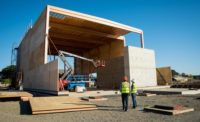
While widely accepted in Europe, designers and builders in the U.S. have struggled to take full advantage of mass timber because of current limitations in prescriptive codes. This fall, government members of the International Code Council will vote to update the International Building Code to include a new Type IV construction category for mass timber. It will, if passed, ensure building officials have the tools they need to keep the IBC relevant to the changing marketplace. The proposed codes are intended to assure the public and fire services that code-compliant tall wood buildings will be safe and strong, with rigorous and redundant systems of fire protection. As they stand, the codes define building types, establish fire-resistance ratings and outline important requirements that ensure consistency.
The proposed code change recognizes that mass timber panels perform differently than traditional dimensional lumber, with more residual strength and enhanced fire resistance.
Demand for urban infrastructure, rising costs, a shortage of skilled labor and greater environmental awareness are driving a search for new delivery methods. The proposed code change recognizes that mass timber panels perform differently than traditional dimensional lumber, with more residual strength and enhanced fire resistance.
If code and fire officials recognize this material, they will help fill the need for more efficient, less labor-intensive techniques.
Because mass timber panels are prefabricated, smaller crews can assemble structures more safely and in less time. The speed advantage is amplified because manufacturing can occur concurrently with site and foundation work, reducing lag time between construction phases and shortening construction time.
My company, Lendlease, completed its first cross-laminated timber (CLT) project at the Candlewood Suites hotel at Redstone Arsenal in Huntsville, Ala., in 2016 and did it 37% faster than our light-gauge metal hotels. We used just 11 workers, about half as many as a traditional project would have needed, and only three were experienced carpenters. Eight were previously unemployed veterans who received on-site training in mass timber during installation.
Accelerated timelines mean that mass timber buildings can be occupied sooner, too, further reducing owners’ carrying costs. As the rapidly expanding mass timber supply chain matures, we can expect that the cost advantages will become even more compelling. The precision and installed dimensional reliability available with CLT components create more opportunity for other off-site prefabrication, and because the solid floor deck offers safe working conditions on the levels below, sub-trades can work concurrently in the building, acting as a multiplier to the speed advantage.
Mass Timber Advantages
The use of CLT reduces the number of parts required to build a building, including the number of details and connection components. Fewer pieces mean more predictable outcomes and a quality-control program that is easier to manage. Lendlease had less than 10 requests for information during the structural erection at Redstone, an impressive number when compared to as many as 200 RFIs on a traditionally built hotel of the same size and scope.
Mass timber’s critics often claim that it is still an unproven building material, pointing to an incident at an Oregon construction site where a mass timber component failed (described in a 9/15 story on ENR.com). Unconfirmed reports indicate that a process change in the manufacturing introduced temperature variations that inadvertently prevented consistent bonding. Third-party quality assurance programs provide a framework for addressing that type of issue going forward. Material failures in traditional mediums happen every day despite decades-old codes and standards. Remember, mass timber is a proven technology—it has been used across the world for about 20 years.
Tall mass timber buildings have achieved an enviable record. Lendlease alone is scheduled to begin over 250,000 sq ft of such buildings in the fourth quarter of this year and another 300,000 sq ft in 2020.
If the International Building Code is to remain relevant, the proposed code changes are essential. Mass timber’s time has clearly arrived.
If you have an idea for a column, please contact Viewpoint Editor Richard Korman at kormanr@enr.com.





